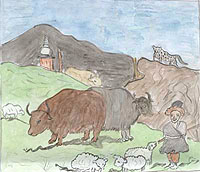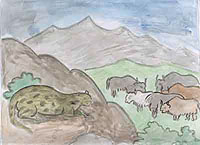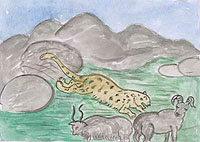A Snow Leopard Glossary
Adaptation
Through the process of natural selection animals undergo changes in their bodies or in the processes within their bodies, or in their behavior. Sometimes they go through changes in two or more of these categories. These changes are in response to factors in their environment. If the changes produce an increase in the long-term reproductive success of the animal, the animal is said to be well adapted to its environment. Animals that are adapted to their environment are able to obtain air, water, and food. They are able to cope with physical conditions such as temperature, light and heat. They are able to defend themselves from their natural enemies, to reproduce, and to respond to changes around them.

Adaptations enable living organisms to cope with environmental stresses and pressures. Adaptation can be structural or behavioral. Structural adaptations are changes in the body parts of an organism that help it to survive in its natural habitat (e.g., skin color, shape, body covering). One common form of physical adaptation is acclimatization. Acclimatization allows the organism to survive in a new environment. One way in which snow leopards have acclimatized is by developing an enlarged nasal cavity to warm the cold air of the high mountains before it enters their lungs. Behavioral adaptations are special ways a particular organism acts to survive in its natural habitat. For instance, snow leopards mark their habitat more intensively than other big cats, which is a behavorial adaptation to the rugged terrain in which they live. Physiological adaptations are systems present in an organism that allow it to perform certain biochemical reactions such as making venom, secreting slime, or being able to keep a constant body temperature. For instance, many cats have developed scent glands that produce a pungent liquid that the cats use to mark their territory.
Alpine and Sub-alpine Zones
Have you noticed that trees don’t grow all the way to the top of very high mountains? At those altitudes trees can’t grow because it’s too cold on too many days of the year even for conifers that are adapted to the cold and snow. In addition, the lack of suitable soil, such as along talus slopes or exposed rock formations, prevent trees from gaining an adequate foothold and expose them to drought and sun. Scientists call the line where trees end the tree line. Above the tree line is the alpine zone. Below the tree line is the sub-alpine zone.
Depredation
The snow leopard’s killing instinct is triggered by movement. If a snow leopard were to get into a pen where a herder was keeping sheep and goats, the snow leopard could continue killing the terrified animals until none were left alive. This would be snow leopard depredation of an extreme order, but it has been known to happen. Such an event would be a great misfortune for the herder who might respond by killing the snow leopard. The Snow Leopard Conservancy works to minimize conflicts like this by helping local herders build predator-proof corrals.

Environment
By “environment” we mean the “natural environment”. In other words, all living and non-living things that occur naturally on Earth. We could also speak of habitat, which is Latin for “it inhabits”, or the area where a particular species lives. Habitat is essentially the natural environment in which an organism lives – the physical environment that surrounds and influences and is utilized by a species.
Indicator Species
Because snow leopards exist at the top of the food chain, they are dependent on the welfare of the species below them. Therefore, where you have good, healthy populations of snow leopards, you can be fairly certain that the rest of the mountain web of life is in good shape.
Pelage
Pelage is a word we get from the French. It means the hairy covering of a mammal. For more information about pelage go to this page.

Scrape
Snow leopards, like other big cats, mark their territory by scuffing the ground with their hind paws creating a scrape.
Web of Life
The Web of Life is a metaphor for thinking about the interconnections between all forms of life on Earth, both plant and animal. For a more detailed explanation go to Kid’s Planet. Perhaps you would like to learn about a game called Web Of Life.
